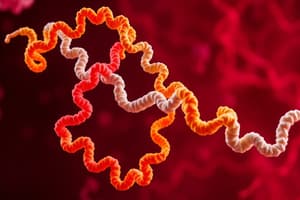Podcast
Questions and Answers
What defines the primary structure of a protein?
What defines the primary structure of a protein?
- The linear sequence of amino acids in a protein (correct)
- The three-dimensional shape of the protein
- The folding patterns within a polypeptide
- The assembly of multiple polypeptide chains
What distinguishes range A from range B in the relationship between substrate concentration and rate of reaction?
What distinguishes range A from range B in the relationship between substrate concentration and rate of reaction?
- Range A shows saturation of enzyme activity.
- Range A has a linear increase in the rate of reaction. (correct)
- Range B exhibits greater enzyme activity than range A.
- Range B is where substrate molecules outnumber active sites.
What occurs at the allosteric site of a protein?
What occurs at the allosteric site of a protein?
- Allosteric binding causes irreversible denaturation.
- Molecules bind to induce conformational changes. (correct)
- Substrate molecules bind to catalyze a reaction.
- The protein unfolds and loses function.
In what way does the tertiary structure differ from the secondary structure of a protein?
In what way does the tertiary structure differ from the secondary structure of a protein?
Which statement best describes quaternary structure?
Which statement best describes quaternary structure?
What happens when substrate concentration increases in range B of enzyme activity?
What happens when substrate concentration increases in range B of enzyme activity?
What best explains allosteric regulation's role in enzyme activity?
What best explains allosteric regulation's role in enzyme activity?
Why does the rate of reaction not significantly increase in range B despite higher substrate concentration?
Why does the rate of reaction not significantly increase in range B despite higher substrate concentration?
Flashcards
Primary Protein Structure
Primary Protein Structure
The linear sequence of amino acids in a protein.
Secondary Protein Structure
Secondary Protein Structure
Local folded structures in a protein chain, formed by interactions in the backbone (e.g., alpha-helices, beta-sheets).
Tertiary Protein Structure
Tertiary Protein Structure
The 3D shape of a single protein molecule.
Quaternary Protein Structure
Quaternary Protein Structure
Signup and view all the flashcards
Enzyme Activity (Low Substrate)
Enzyme Activity (Low Substrate)
Signup and view all the flashcards
Enzyme Activity (High Substrate)
Enzyme Activity (High Substrate)
Signup and view all the flashcards
Allosteric Regulation
Allosteric Regulation
Signup and view all the flashcards
Allosteric Site
Allosteric Site
Signup and view all the flashcards
Study Notes
Protein Structure and Function
- Primary Structure: The linear sequence of amino acids in a protein.
- Secondary Structure: Local folded structures within a polypeptide (e.g., alpha-helices, beta-sheets) formed by interactions between backbone atoms.
- Tertiary Structure: The three-dimensional shape of a single protein molecule.
- Quaternary Structure: The structure formed by the assembly of multiple polypeptide chains (subunits).
Enzyme Activity and Substrate Concentration
- Figure 1: Shows the relationship between substrate concentration and reaction rate.
- Range A: The rate of reaction increases linearly with substrate concentration.
- There are more active sites available on the enzyme than substrate molecules.
- Range B: The reaction rate plateaus, approaching a maximum rate (Vmax).
- Nearly all the enzyme's active sites are occupied.
- Increasing substrate concentration doesn't significantly increase the reaction rate.
Allosteric Regulation
- Allosteric regulation controls enzyme activity by binding a molecule (inhibitor or activator) to an allosteric site (a site other than the active site).
- This binding causes a conformational change in the enzyme, which either activates or inhibits its activity.
- This allows fine-tuned control of metabolic pathways in response to changing cellular conditions.
Studying That Suits You
Use AI to generate personalized quizzes and flashcards to suit your learning preferences.



